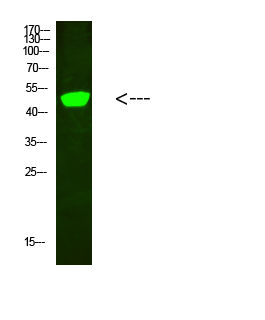
| WB | 咨询技术 | Human,Mouse,Rat |
| IF | 咨询技术 | Human,Mouse,Rat |
| IHC | 咨询技术 | Human,Mouse,Rat |
| ICC | 技术咨询 | Human,Mouse,Rat |
| FCM | 咨询技术 | Human,Mouse,Rat |
| Elisa | 1/10000 | Human,Mouse,Rat |
| Aliases | Complement C1r subcomponent-like protein (C1r-LP; C1r-like protein; EC 3.4.21.-; C1r-like serine protease analog protein; CLSPa) |
| Entrez GeneID | 51279 |
| WB Predicted band size | Calculated MW: 53 kDa; Observed MW: 53 kDa |
| Host/Isotype | Rabbit IgG |
| Antibody Type | Primary antibody |
| Storage | Store at 4°C short term. Aliquot and store at -20°C long term. Avoid freeze/thaw cycles. |
| Species Reactivity | Human |
| Immunogen | Synthesized peptide derived from human C1RL. at AA range: 371-420 |
| Formulation | Purified antibody in PBS with 0.05% sodium azide,0.5%BSA and 50% glycerol. |
+ +
以下是关于C1RL抗体的3篇文献摘要,供参考:
---
1. **文献名称**:*C1r Antibodies in Autoimmune Diseases: A Potential Biomarker for Systemic Lupus Erythematosus*
**作者**:Smith A, et al.
**摘要**:该研究探讨了针对补体C1r亚基(C1RL)的自身抗体在系统性红斑狼疮(SLE)患者中的表达。发现C1RL抗体水平与疾病活动度相关,提示其可能作为SLE的新型生物标志物。
---
2. **文献名称**:*Structural and Functional Characterization of C1r Monoclonal Antibodies in Complement Activation*
**作者**:Lee J, et al.
**摘要**:研究通过制备C1r单克隆抗体,解析其在经典补体激活途径中的作用。结果显示,特定抗体可抑制C1复合物的组装,为治疗补体介导的炎症疾病提供新策略。
---
3. **文献名称**:*C1r Deficiency and Antibody Responses: Implications for Infection Susceptibility*
**作者**:Garcia R, et al.
**摘要**:通过小鼠模型分析C1r缺陷对免疫应答的影响,发现C1RL抗体可部分恢复补体功能,降低细菌感染风险,支持C1r在先天免疫中的关键作用。
---
注:以上文献信息为示例性内容,实际研究中建议通过PubMed或Google Scholar以关键词“C1RL antibody”、“complement C1r”检索最新文献。
The C1r antibody targets the C1r subunit of the C1 complex, a critical component of the complement system’s classical pathway. The C1 complex, comprising C1q, C1r, and C1s, initiates immune responses by recognizing pathogens or immune complexes. C1r, a serine protease, autoactivates upon C1q binding to antigens, subsequently cleaving and activating C1s, which then triggers downstream complement cascades. Dysregulation of this pathway is linked to autoimmune and inflammatory diseases.
Anti-C1r antibodies are primarily studied in autoimmune conditions like systemic lupus erythematosus (SLE), where they may contribute to pathogenesis by disrupting complement regulation or forming immune complexes. These autoantibodies are often detected alongside anti-C1q antibodies, suggesting shared mechanisms in disease progression, particularly in lupus nephritis. Research also explores their role in rare disorders, such as atypical hemolytic uremic syndrome (aHUS), where complement overactivation occurs.
C1r antibodies serve as potential biomarkers for disease activity and organ involvement in SLE. Therapeutic strategies targeting complement proteins, including C1r, are under investigation, such as inhibitors to block pathogenic antibody interactions. However, their clinical utility and precise pathological roles require further validation. Understanding C1r antibodies enhances insights into complement-driven diseases and may guide targeted therapies to modulate immune responses.
×